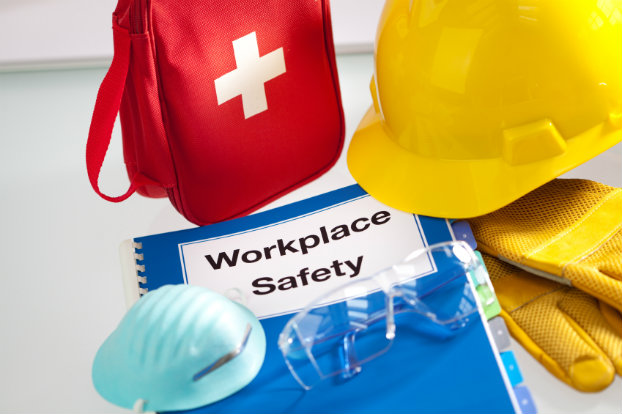Businesses of all sizes face challenges in planning for capital expenditures. Unfortunately, safety training and health management planning is not always a top priority. The cost of poor planning and lack of safety training can hit businesses hard. Spend on occupational injuries and illnesses currently tops $170 billion per year, expenses that come directly out of a company’s profit margin, much of which could be avoided with proper safety training and planning.
Accidents in the workplace range from frivolous to fatal. In a news release, the Bureau of Labor Statistics (BLS) shared the latest, sobering statistics. It reported 4,405 fatal work injuries were recorded in the U.S. in 2013, or 3.2 out of every 100,000 full-time employees. Fatal transportation incidents decreased by 10 percent in 2013 but still accounted for 20 percent of work-related injuries in 2013. Meanwhile, common accidents such as trip-and-falls, electrocution and falling objects led to the most fatalities, with contract worker fatalities accounting for 17 percent of all fatal injuries.
The Importance of Workplace Safety
Safety in the workplace is critical. Beyond avoiding unfortunate accidents, there are many reasons businesses should make it a priority. Proper safety training limits liability exposure, and there are deeper, hidden benefits as well. A safe work environment reflects positively on a company and gives them a competitive edge in recruitment. It affects retention rates and increases worker productivity by preventing accidents before they happen. It saves money by reducing workers compensation claims and avoiding the costs of onboarding new employees.
To help employees understand the value of safety training and injury prevention, businesses can leverage a number of tactics.
 Become safety savvy: Before businesses can teach employees about workplace safety, they need to become knowledgeable themselves. The Occupational Safety & Health Administration (OSHA) is a good place to start. OSHA offers free consultations as a way to get started.
Become safety savvy: Before businesses can teach employees about workplace safety, they need to become knowledgeable themselves. The Occupational Safety & Health Administration (OSHA) is a good place to start. OSHA offers free consultations as a way to get started. Communicate: Businesses should communicate with employees regularly about safety. They can start by offering OSHA training and posting notices in conspicuous areas around the office. These notices help employees to become aware of safety rules, first aid procedures, hazardous material handling and more. Businesses should also hold regular workplace safety events and include safety tips in communications such as employee newsletters.
Communicate: Businesses should communicate with employees regularly about safety. They can start by offering OSHA training and posting notices in conspicuous areas around the office. These notices help employees to become aware of safety rules, first aid procedures, hazardous material handling and more. Businesses should also hold regular workplace safety events and include safety tips in communications such as employee newsletters. Make it policy: Businesses should make employee safety part of their employee manual. This demonstrates to all employees that safety is a priority and provides incentives for workers to consider safety protocols during the performance of their duties.
Make it policy: Businesses should make employee safety part of their employee manual. This demonstrates to all employees that safety is a priority and provides incentives for workers to consider safety protocols during the performance of their duties. Offer ongoing incentives and conduct reviews: Businesses should perform regular, unannounced audits to ensure employees are following proper safety techniques and wearing appropriate safety gear on the job. In addition, businesses can reward employees and teams that perform well on reviews, maintain long-standing safety records and regularly focus on safety education.
Offer ongoing incentives and conduct reviews: Businesses should perform regular, unannounced audits to ensure employees are following proper safety techniques and wearing appropriate safety gear on the job. In addition, businesses can reward employees and teams that perform well on reviews, maintain long-standing safety records and regularly focus on safety education. Make it fun: Some businesses who want to prioritize safety have started to incorporate games into their training programs such as races to create safety kits that adhere to compliance standards, mazes that test employees’ knowledge of emergency escape routes, and art contests to see which groups can accurately depict visual safety guidelines.
Make it fun: Some businesses who want to prioritize safety have started to incorporate games into their training programs such as races to create safety kits that adhere to compliance standards, mazes that test employees’ knowledge of emergency escape routes, and art contests to see which groups can accurately depict visual safety guidelines.
Safety awareness takes more than a one-time training. Workplaces with the best compliance rates are those who regularly talk about safety, establish communication and demonstrate its everyday value.
Safety Starts at the Top
Like most aspects of a company’s culture, an effective safety program starts with upper management. When employees see executives place a high value on safety training, they will tend to follow. Executives who establish open lines of communication, request frequent feedback and prioritize safety create cultures of compliance, security and satisfaction, as well as a workplace with far fewer accidents.
Businesses that need help building a safety program should start by consulting with a trusted advisor or seeking expert assistance until it is up and running. Your employees may never know just how important your efforts really are, but if your program is an effective one, you’re helping your business avoid the unexpected and sometimes devastating cost of poor planning and lack of safety training.



